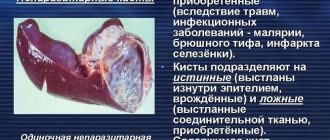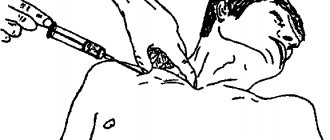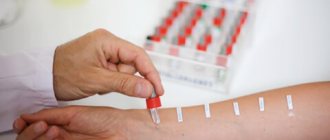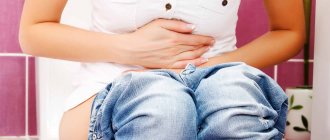Pain during menstruation can be either a type of normal or a symptom of gynecological pathologies. It is quite difficult to determine on your own which option we are talking about. Therefore, if you have very painful periods, consult your doctor.
Our clinic employs specialists with extensive experience, and the diagnostic facilities of our clinic allow you to undergo an examination without leaving the building. This will allow you to quickly determine the cause of the disease and prescribe effective treatment.
Reasons why your stomach and lower back hurt these days
The reason lies in the physiology of the occurrence of menstruation itself.
Normally, after the first menstruation, every girl has a cycle: approximately once a month, one egg matures in her ovaries and is released into the uterus, which is ready to be fertilized (ovulation). If fertilization does not occur, it dies, and the body’s task is to get rid of it. For this, nature has invented a special mechanism: at a certain point, the vessels of the uterus narrow and block the blood flow, and the uterine tissue begins to be rejected along with the egg - this is menstrual flow, which is why the lower abdomen hurts during menstruation.
Next to the female genital organs in the pelvic cavity there are others: the rectum, bladder, soft tissues, blood vessels and nerves, which can also cause pain. This is why the lower back and lower abdomen hurt during menstruation.
Thus, pain during menstruation is an acceptable phenomenon, but in some cases it can also be a consequence of pathology. Here is a list of diseases that can cause painful periods.
Endometriosis
A disease in which cells from the uterine cavity are carried outside of it, undergoing cyclic changes.
This may be the reason why the lower back hurts during menstruation if the cells get outside the uterus.
Uterine fibroids
This is a benign tumor. It may manifest itself as cramping pain in the lower abdomen during menstruation, or constant pain in the lower abdomen.
Genital infections
An infectious agent can enter the vagina, uterus and ovaries and cause inflammation. This group includes sexually transmitted diseases (gonorrhea, syphilis, chlamydia and others). These are “silent” pathogens that can go unnoticed for a long time. And sometimes this is the reason why there is pain in the pelvic area during menstruation.
Intrauterine device
Painful and heavy menstruation, history of IUD insertion. Intrauterine synechiae are adhesions that weld the walls of the uterus together and cause its deformation. They are manifested by painful menstruation, constant pain in the lower abdomen, a decrease in the amount of blood lost during menstruation and its duration, a history of abortion, childbirth, intrauterine manipulation.
Forms of painful periods
Modern medicine is constantly evolving, and today there are three main forms of dysmenorrhea. According to ICD-10 (International Classification of Diseases), primary, secondary and unspecified dysmenorrhea or algomenorrhea are distinguished.
The primary form means that there are no pathological changes in the structure of the genital organs, that is, there are no serious diseases that can cause heavy bleeding and pain.
The secondary form is characterized by the presence of gynecological diseases. They are the ones behind painful periods.
The unspecified form is given in cases where the diagnosis could not identify the true cause, but this is unlikely1.
Very often, painful periods are directly related to irregularities in the menstrual cycle.
Treatment
It is worth noting that not in every case, abdominal pain during menstruation requires treatment; this is an acceptable phenomenon that you need to learn to live with. What to do with pain during menstruation that does not cause severe discomfort and is tolerable is to try to abstain from pills.
In cases where spasms interfere with work and leading a normal lifestyle, you can take antispasmodics (No-shpa, Drotaverin, Spazmalgon, etc.). When diseases are detected, special treatment is used.
Doctor's advice
For any pathological conditions, including pain during menstruation, you should always seek advice from a gynecologist. Any problem always has a solution, when it comes to organic pathology, the sooner treatment begins, the higher the chance of its effectiveness
Olga Zorina Pregnancy and childbirth, Gynecologist, Gynecologist-endocrinologist
from uterine fibroids , and the incidence increases with age. And in many cases, fibroids are not treated in any way, but observational tactics are used: often after menopause it disappears on its own. In the opposite situation, hormones and surgery are used. Read about the size of fibroids for surgical intervention here.
Urinary tract infections are treated with appropriate antibacterial drugs. Only a doctor can prescribe the correct treatment after receiving test results.
Intrauterine device - removal from the uterine cavity, synechia of the uterine cavity - hysteroscopy.
A gynecologist diagnoses and treats diseases of the female organs. You can visit a gynecologist online and get an answer to your specific problem.
Causes of painful periods after childbirth
Quite often, young mothers complain of painful periods after childbirth. In most cases, natural childbirth causes a sharp development of the above reasons. Both the primary form and the secondary form of dysmenorrhea can occur, for example, against the background of endometriosis.
In addition, pain is observed when feeding a child, especially during menstruation. When breastfeeding, a reflex reaction occurs and the uterus contracts, causing discomfort or pain during menstruation. If the birth was difficult, and there were injuries or ruptures, then menstruation can also cause additional pain until the body fully recovers. The same applies to girls who have had a caesarean section.
Tablets for stomach pain with prices
At the moment, there is a wide range of painkillers on the market, differing in the type of action and cost, which is why it is not easy to choose the right ones among them. Below are tablets for abdominal pain during menstruation, which can be used to relieve algomenorrhea.
| Drug name | Price, rub.) |
| No-shpa | 100-200 |
| Papaverine | 60-100 |
| Drotaverine | 30-60 |
| Spasmalgon | 250-350 |
| Buscopan | 350-450 |
| Analgin | 20-50 |
| Pentalgin | 100-200 |
| Ibuprofen | 30-70 |
| Diclofenac | 30-60 |
| Ketoprofen | 80-120 |
| Spasmalin | 400-500 |
| Next | 100-200 |
Associated symptoms
With painful periods, it is important to pay attention not only to the nature of the pain, but also to the accompanying symptoms. Algomenorrhea may be accompanied by the following symptoms:
- nausea up to vomiting, diarrhea;
- severe headache;
- increased sweating, hot flashes, dizziness and fainting;
- sudden changes in blood pressure, racing pulse or increased heart rate;
- weakness, muscle and joint pain.
The duration of the menstrual cycle may be disrupted and the duration of the monthly discharge itself increases, they become abundant or, conversely, scanty. Between menstruation, bloody leucorrhoea sometimes occurs in the form of spotting. Pain due to dysmenorrhea may not appear on the first day of menstruation, but 1-2 days before its onset. They have a pulling, cutting, aching or cramp-like nature and pass only after the end of menstruation. In cases of severe secondary dysmenorrhea, pain may be felt throughout the entire menstrual cycle.
Diagnostics and examinations
Examination for algodismenorrhea includes the following manipulations: consultation and examination by a gynecologist. A manual examination can detect changes and mass formations in the abdominal organs, and with the help of mirrors the doctor will assess the condition of the cervix.
A smear from the vagina and cervix diagnoses infections and tissue degeneration.
- An ultrasound of the pelvic organs will detect changes in deep tissues.
- Blood, urine and stool tests are ordered to assess the general condition of the body and the presence of infection.
- CT and MRI allow detailed visualization of all organs and detection of pathology.
- To clarify the diagnosis, the following may also be prescribed: curettage of the uterine cavity, fibrocolonoscopy, laparoscopy and other methods.
Oral contraceptives (COCs)
Hormonal contraceptives are very common in use for initial dysmenorrhea, especially in women of sexually active age.
Combined oral contraceptives (COCs) are considered the most effective in this regard; they contain an imitation of the hormone estrogen.
The principle of their activity is aimed at suppressing the ovulation process, because of this the amount of prostaglandins decreases, and the painful syndrome disappears.
In addition, the pressure inside the uterine cavity decreases and the frequency and strength of contractile tension of smooth muscles slows down, which reduces pain.
Prevention
No specific prophylaxis is carried out.
Risk factors:
- early age of menarche;
- long periods;
- smoking (active, passive);
- family history;
- physical inactivity;
- frequent stressful situations in the family;
- frequent changes in life;
- low socio-economic status.
Consulting on healthy lifestyle issues (cessation of smoking, moderate physical activity, prevention of stressful situations).
Statistics
70% of women of reproductive age face the problem of painful periods, but only 10% of them complain of unbearable cramp-like pain during their menstrual periods. Statistics say that pain syndrome is complemented by other symptoms:
- 17% of women experience fainting due to pain;
- 23% of the fair sex suffer from dizziness and another 13% from headaches;
- in 84% of cases vomiting occurs;
- 79% of women complain of diarrhea.
What to do if your stomach hurts badly and when you need to see a doctor
What to do if you have severe pain during menstruation, when the cramps cannot be tolerated?
For painful menstruation, you can use NSAIDs (Indomethacin, Diclofenac, Aspirin, Ketoprofen); antispasmodics (magnesium tablets taken orally during pain, long-term for 5–6 months); sedative therapy (valerian extract 1 tablet 3 times a day, taken orally for 10 days).
If a problem arises, do not hesitate; you need to seek help from a specialized specialist. You can easily solve your problem with a gynecologist online.
Be healthy! Find out about the causes of pain in the lower abdomen from the video:
This article has been verified by Olga Zorina, a current qualified physician, and can be considered a reliable source of information for site users.
Rate how helpful this article was
4.4 30 people voted, average rating 4.4
Did you like the article? Save it to your wall so you don’t lose it!
Degrees of pain severity
Pain during menstruation is called dysmenorrhea (outdated names are algomenorrhea and algomenorrhea). According to statistics, approximately 80% of women suffer from menstrual pain of varying severity.
Usually, unpleasant sensations develop within the first 4 hours after the start of menstruation and last for 1-2 days. However, in severe cases, pain can occur several days before the start of menstruation and continue for several days or until the end of menstruation.
Dysmenorrhea has 3 degrees:
- Mild - such pain is insignificant, observed only on the first day of menstruation, is not accompanied by other symptoms and does not interfere with leading a normal lifestyle.
- Moderate - pain can last up to 2-3 days of menstruation, other signs of malaise also appear (nausea, weakness, headache), and although unpleasant sensations disrupt the usual rhythm of life, the patient does not lose her ability to work and can go to work or school.
- Severe – pain develops even before the onset of menstruation and can continue until it ends, ability to work is significantly reduced or completely lost, accompanying symptoms are also very pronounced.
Psycho-emotional signs
The main reason for the arrival of regular menstruation is a change in hormonal levels. Fluctuations in the level of estrogen and progesterone directly affect a woman’s emotional state and mood. The luteal phase of the menstrual cycle is characterized by low levels of estrogen and high levels of progesterone. The serotonin level is minimal. These indicators determine psycho-emotional symptoms before menstruation. The main ones are:
- rapid mood changes;
- sudden irritability;
- bouts of crying;
- state of anger, symptoms of aggression before the onset of menstruation;
- sleep disturbance;
- feeling depressed;
- apathy;
- constant fatigue;
- lethargy and general weakness before menstruation;
- frequent overwork;
- emotional outbursts;
- depression;
- anxiety;
- feelings of worthlessness and hopelessness;
- lack of interest in everyday life;
- decline in spiritual strength;
- problems with concentration;
- drowsiness before menstruation.
Premenstrual syndrome is indicated by the presence of 5 or more symptoms over several months.
Stages of PMS
Every woman experiences PMS symptoms differently. Experts distinguish three main stages:
- The compensated stage is characterized by mild negative changes. The pain disappears on the first day of discharge. This stage is stable over a long period of time.
- The subcompensated form has painful symptoms that intensify over the years. The duration of PMS can reach 1 month.
- The decompensated phase of PMS occurs after menstruation.
Signs of critical days appear in varying degrees - from mild to severe. This depends on the general health of the woman, as well as heredity.
How to behave during menstruation?
Menstruation is a normal phenomenon in the body of any woman. This period should not significantly affect your lifestyle. But you need to follow some rules so that problems do not arise during your period.
Hygiene is an important issue. This includes a daily shower and change of linen. Girls can use pads and sanitary tampons.
Modern pads for critical days are thin multi-layer napkins, the bottom oilcloth layer of which reliably protects the linen. They differ in the degree of absorption and size. They are changed, regardless of how full they are, at least every 3-4 hours. Why can't you do this less often?
There is a gap between the pad and the vaginal opening. Menstrual blood flows freely and drips onto the pad, but can stain the skin of the perineum and linger on the vulva.
Blood is a breeding ground for bacteria, and increased humidity and heat create favorable conditions for their reproduction. The degree of microbial contamination on the vulva is very high, so menstrual blood is quickly decomposed by bacteria. A pungent odor appears. Therefore, rarely changing pads is unhygienic.
Girls can also use tampons. They will not damage the hymen. For virgins, special tampons of minimal size are suitable.
Under the influence of estrogen, the hymen tissue softens and becomes slightly folded, so it does not interfere with the insertion of a tampon. Its use may be difficult only if there is an abnormal development of the hymen or vagina.
The tampon needs to be replaced every 3-4 hours, the maximum allowable time for its presence is 7-8 hours. If you change a dry tampon too often, mechanical irritation of the vagina will occur. Changing swollen tampons less frequently can cause infection and toxic shock.
In addition to hygiene, many girls are interested in the question of playing sports on menstruation days. There are no absolute contraindications to this. On the contrary, moderate physical exercise can reduce the severity of pain and keep the body in good shape.
Too intense exercise is not recommended in the first two days, when bleeding is most pronounced. You should not lift heavy objects or visit the bathhouse or sauna these days. Properly selected tampons will not interfere with swimming, dancing and training.











